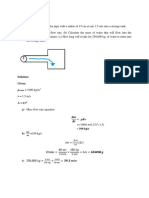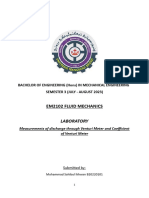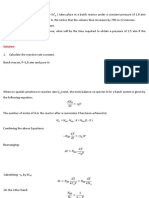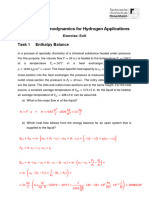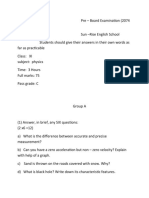ME525SP2023HW4
ME525SP2023HW4
Uploaded by
Dylan HsiehCopyright:
Available Formats
ME525SP2023HW4
ME525SP2023HW4
Uploaded by
Dylan HsiehCopyright
Available Formats
Share this document
Did you find this document useful?
Is this content inappropriate?
Copyright:
Available Formats
ME525SP2023HW4
ME525SP2023HW4
Uploaded by
Dylan HsiehCopyright:
Available Formats
ME 525: Spring 2023 Homework 4
Date Assigned: 24 February 2023 Date Due: 10 March 2023
(1) Study the model for a constant volume adiabatic reactor developed in class lecture 16 and
apply it to the combustion of carbon monoxide 𝐶𝑂)with moist air 𝑂 + 3.76𝑁 +
𝑁 𝐻 𝑂 at an initial temperature of 1000 K and an initial pressure of 1 atm and an initial
equivalence ratio of 0.25 in a constant volume adiabatic reactor without any mode of work
transfer. Assume:
(i) constant with respect to temperature but variable with respect to composition specific
heats evaluated at 2000 K;
(ii) the following global mechanism of Glassman and Dryer applies:
1 ,
𝐶𝑂 + 𝑂 𝐶𝑂
2
Where the forward and reverse reaction rates are expressed as:
𝑑 𝐶𝑂
= −𝑘 𝐶𝑂 𝐻 𝑂 𝑜
𝑑𝑡
𝑑 𝐶𝑂
= −𝑘 𝐶𝑂
𝑑𝑡
𝐽
𝑘𝑚𝑜𝑙 . 1 −1.674 10 ) 𝑘𝑚𝑜𝑙
𝑘 = 2.24 10 ) 𝑒𝑥𝑝
𝑚 𝑠 𝐽
𝑅𝑢 𝑘𝑚𝑜𝑙 𝐾) 𝑇 𝐾)
𝐽
1 −1.674 10 ) 𝑘𝑚𝑜𝑙
𝑘 = 5.0 10 ) 𝑒𝑥𝑝
𝑠 𝐽
𝑅𝑢 𝑘𝑚𝑜𝑙 𝐾) 𝑇 𝐾)
(1A) Write out all the necessary equations to describe your model, explicitly expressing them in
terms of: the molar concentrations: 𝐶𝑂 , 𝑂 , 𝐶𝑂 , 𝐻 𝑂 , 𝑎𝑛𝑑 𝑁 , individual values of
constant pressure specific heats: 𝑐̅ , , 𝑐̅ , , 𝑐̅ , , 𝑐̅ , , 𝑎𝑛𝑑 𝑐̅ , , Note that 𝐻 𝑂 is a catalyst
and its initial mass is conserved (but its’ enthalpy, mole fraction, partial pressure may change) in
the constant volume reactor.
(1B) Determine the influence of varying the initial moles of water vapor (𝑁 )from values
corresponding to mole fractions of 1% to 3%.
(2) Consider a tube furnace with a diameter of 0.30 m, as shown on text book page 218. A natural
gas flowing at a rate of 0.0147 kg/s (considered to be methane) – air mixture at an equivalence
ratio of 0.9 is burned in a rapid mixing burner leading to a hot gas mixture temperature of 2350 K
at the inlet of the furnace, and heat is transferred from the hot products to the wall with a constant
wall temperature of 600 K), leading to a hot gas mixture exit temperature of 1700 K. Assume that
the combustion process at the burner does not form any nitic oxide 𝑁𝑂 but the post flame gases
do. Further assume that the additional constraints and simplifications regarding the pressure, flow,
wall heat transfer and chemical kinetics given in the text book on page 218 apply.
(2A) Find the length of the furnace.
(2B) Find the NO mole fraction at the exit considering the forward and the reverse Zeldovich
kinetics.
You might also like
- Solution Manual LevenSpiel by 13BCH@ITNUDocument370 pagesSolution Manual LevenSpiel by 13BCH@ITNUManishMakwana87% (156)
- ME 1a - TOPIC 2 First Law of ThermodynamicsDocument10 pagesME 1a - TOPIC 2 First Law of Thermodynamicsjohn reyche garsuta100% (3)
- Fiat Kobelco Wheel Loader w50-w60-w70 Service ManualDocument594 pagesFiat Kobelco Wheel Loader w50-w60-w70 Service Manualjony100% (4)
- 1988 1998 Physics Past PapersDocument168 pages1988 1998 Physics Past PapersAnthony Benson100% (1)
- The Impact of Design and Operating Parameters On Skull Formation in A Blast Furnace HearthDocument14 pagesThe Impact of Design and Operating Parameters On Skull Formation in A Blast Furnace HearthmetalmasaNo ratings yet
- Gas MixDocument20 pagesGas Mixİkigül Aşçıevladı KirlitaşNo ratings yet
- CHEN2000 FinalDocument10 pagesCHEN2000 FinalKHÁNH VÂN DIỆPNo ratings yet
- Reactor Computations PFR-100v0.5Document10 pagesReactor Computations PFR-100v0.5Evan DulayNo ratings yet
- FileDocument6 pagesFiletech2lifeNo ratings yet
- Chemical Engineering ThermodynamicsDocument10 pagesChemical Engineering ThermodynamicsP P DNo ratings yet
- Chapter 2 Process Modelling Fundamental RelationsDocument28 pagesChapter 2 Process Modelling Fundamental Relationsnik farisNo ratings yet
- PTD720S Assignment 2 MemoDocument8 pagesPTD720S Assignment 2 MemoShaheed MorweNo ratings yet
- Lecture 23Document22 pagesLecture 23Dinuja SenevirathneNo ratings yet
- Reactors Design - 1603888, 1599618 I 1603509Document9 pagesReactors Design - 1603888, 1599618 I 1603509saramartori.2002No ratings yet
- Advanced Molecular DynamicsDocument11 pagesAdvanced Molecular Dynamicsquarksteam2023No ratings yet
- Tarea 5-Equipo18Document33 pagesTarea 5-Equipo18Sarita Betancur RamírezNo ratings yet
- Edited FileDocument21 pagesEdited FileRochelle Ashley LaoNo ratings yet
- First LawDocument10 pagesFirst LawAhmed Al-ayatNo ratings yet
- MEG506 - Exam - 2020 - 21 - Model Answers and Marking SchemeDocument6 pagesMEG506 - Exam - 2020 - 21 - Model Answers and Marking Schemeajahbenjamin1No ratings yet
- ENGG2500 2019 Mid SolDocument6 pagesENGG2500 2019 Mid Solhuinicholas001No ratings yet
- 02 - 23-24 - TLS - Energy Balances - Detailed SolutionsDocument18 pages02 - 23-24 - TLS - Energy Balances - Detailed SolutionsdeblijthomasNo ratings yet
- Chapter 3 Constitutive Relations (Self Revision) SolutionsDocument4 pagesChapter 3 Constitutive Relations (Self Revision) Solutionsnik farisNo ratings yet
- Thermodynamics 1 DiscussionDocument29 pagesThermodynamics 1 DiscussionFamela GadNo ratings yet
- Improving Power Density of Free-Piston Stirling Engines: NASA Glenn Research Center, Cleveland, OH, 44121Document10 pagesImproving Power Density of Free-Piston Stirling Engines: NASA Glenn Research Center, Cleveland, OH, 44121Skylar GreyNo ratings yet
- Project Work - CMDocument4 pagesProject Work - CMad599066No ratings yet
- Part 1 Dynamic Modeling - 2022Document19 pagesPart 1 Dynamic Modeling - 2022MUHAMMAD LUQMAN HAKIMI MOHD ZAMRINo ratings yet
- Practical ReactionDocument8 pagesPractical ReactionToMemNo ratings yet
- Lecture 15Document5 pagesLecture 15JOSE CARLOS LEON GONZALEZNo ratings yet
- Chemical Kinetic 2Document5 pagesChemical Kinetic 2azadqayoommalikNo ratings yet
- Reactive Energy BalanceDocument12 pagesReactive Energy BalanceGrey DaveNo ratings yet
- Tugas Termo DameDocument13 pagesTugas Termo DamedesisitompulNo ratings yet
- 3 Heat TransferDocument21 pages3 Heat Transferz5c6h6m9gjNo ratings yet
- FM IntroductionDocument14 pagesFM IntroductionJayden PangilinanNo ratings yet
- 2nd Assignment of MS2120 Basic Engineering Thermodynamics Semester I 20192020Document4 pages2nd Assignment of MS2120 Basic Engineering Thermodynamics Semester I 20192020Ghina RamadhanNo ratings yet
- Tugas 3 - TRK 02 - Kelompok 4Document24 pagesTugas 3 - TRK 02 - Kelompok 4Sulthan DaffaNo ratings yet
- Problem 2: First and Second Law of Thermodynamics Thermodynamics Coursechemical Engineering DepartmentDocument17 pagesProblem 2: First and Second Law of Thermodynamics Thermodynamics Coursechemical Engineering DepartmentTita Ari UtamiNo ratings yet
- Venturi Meter Report FinalDocument11 pagesVenturi Meter Report FinalSahibul IkhwanNo ratings yet
- Week 7 Tutorial Chem R Eng 22-01-23Document12 pagesWeek 7 Tutorial Chem R Eng 22-01-23Zain Ul AbedinNo ratings yet
- Buoyancy Induced Flow in A CavityDocument11 pagesBuoyancy Induced Flow in A Cavitysk21meb0b55No ratings yet
- Simulation Paper Nit RourkelaDocument2 pagesSimulation Paper Nit RourkelaYASHNo ratings yet
- Physics 1 LanmanDocument21 pagesPhysics 1 LanmanMerve İzNo ratings yet
- At DarshanDocument127 pagesAt DarshanBabaluNo ratings yet
- University of The Philippines Chemical Engineering Society, Inc. (UP KEM)Document8 pagesUniversity of The Philippines Chemical Engineering Society, Inc. (UP KEM)AcademicBMNo ratings yet
- Week 06Document20 pagesWeek 06Khaldoun AlmomaniNo ratings yet
- Flow of Compressible Fluids - UnlockedDocument32 pagesFlow of Compressible Fluids - UnlockedBianca BayumbonNo ratings yet
- Test 03Document2 pagesTest 03mbzeelahNo ratings yet
- FlowProcesses 2Document52 pagesFlowProcesses 2pelinbarnNo ratings yet
- H2 Thermo Ex EOS Solution 02Document5 pagesH2 Thermo Ex EOS Solution 02joubsnNo ratings yet
- Solutions Tutorials Session 1Document8 pagesSolutions Tutorials Session 1Mark ApostolNo ratings yet
- Adsorption M + S . (K, K) - R K C (1 - ) 2. Reaction 3A + M.S T.S + 2H O (K) - R K C 3. Desorption T.S T + S (K, K) - R K - K - (1 - )Document3 pagesAdsorption M + S . (K, K) - R K C (1 - ) 2. Reaction 3A + M.S T.S + 2H O (K) - R K C 3. Desorption T.S T + S (K, K) - R K - K - (1 - )ToMemNo ratings yet
- Chem 122-Gaseous State Tutorial-SolutionsDocument6 pagesChem 122-Gaseous State Tutorial-SolutionsWamaka GhambiNo ratings yet
- ProblemsDocument32 pagesProblemsjosiedabatosNo ratings yet
- Problem Sheet 10Document3 pagesProblem Sheet 10Rashmi SahooNo ratings yet
- Mathematical Analysis 1: theory and solved exercisesFrom EverandMathematical Analysis 1: theory and solved exercisesRating: 5 out of 5 stars5/5 (1)
- A-level Maths Revision: Cheeky Revision ShortcutsFrom EverandA-level Maths Revision: Cheeky Revision ShortcutsRating: 3.5 out of 5 stars3.5/5 (8)
- (2D Simulation) Thermal Power Plant Upgrade Via A Rotating Detonation Combustor andDocument11 pages(2D Simulation) Thermal Power Plant Upgrade Via A Rotating Detonation Combustor andDylan HsiehNo ratings yet
- Homework2 ME505Document6 pagesHomework2 ME505Dylan HsiehNo ratings yet
- Assignment IDocument1 pageAssignment IDylan HsiehNo ratings yet
- Assignment IDocument4 pagesAssignment IDylan HsiehNo ratings yet
- ch2、3熱組卡式座標Document16 pagesch2、3熱組卡式座標Dylan HsiehNo ratings yet
- Combustion Assignment2Document8 pagesCombustion Assignment2Dylan HsiehNo ratings yet
- Rev Lect ThermodynamicDocument37 pagesRev Lect Thermodynamicapi-26797747No ratings yet
- Syltherm XLT PDFDocument2 pagesSyltherm XLT PDFvijayNo ratings yet
- Temperature DistributionDocument4 pagesTemperature DistributionAsishNo ratings yet
- Heat Exchanger Fundamentals: Heat Exchange Concepts & Heat ExchangersDocument3 pagesHeat Exchanger Fundamentals: Heat Exchange Concepts & Heat ExchangersGustavNo ratings yet
- HT QuestionsDocument3 pagesHT QuestionsSanthoshirathnam GunjaNo ratings yet
- Final Question Paper 11 Sun RiseDocument6 pagesFinal Question Paper 11 Sun RiseOne WorldNo ratings yet
- International Business ParkDocument178 pagesInternational Business ParkShonyka Mugi100% (1)
- Fundamental Study of Wax Deposition in Crude Oil Flows in A Pipeline Via Interface-Resolved Numerical SimulationsDocument20 pagesFundamental Study of Wax Deposition in Crude Oil Flows in A Pipeline Via Interface-Resolved Numerical SimulationsEdi Agurto CarrascoNo ratings yet
- TOS Grade8 ScienceDocument5 pagesTOS Grade8 ScienceJessah Chris Eve ValleNo ratings yet
- Ercsc EgcscDocument57 pagesErcsc EgcscMega Jaya TeknikNo ratings yet
- Revision Notes On A LevelDocument55 pagesRevision Notes On A LevelZainab PeerbuxNo ratings yet
- 126ef052017 PDFDocument2 pages126ef052017 PDFAsheesh Kumar100% (1)
- Lecture 5Document9 pagesLecture 5Shakil AhmedNo ratings yet
- Three-Dimensional CFD Simulation Ofa "Steam Water Spray" Retort Process For Food Vegetable ProductsDocument15 pagesThree-Dimensional CFD Simulation Ofa "Steam Water Spray" Retort Process For Food Vegetable ProductsWilliam Rolando Miranda ZamoraNo ratings yet
- P4. Fungsi Keadaan Dan Diferensial EksakDocument8 pagesP4. Fungsi Keadaan Dan Diferensial EksakAnis AnisaNo ratings yet
- The Gibbs Function (Gibbs Energy)Document11 pagesThe Gibbs Function (Gibbs Energy)saadNo ratings yet
- Kinds of Thermodynamic ProcessesDocument6 pagesKinds of Thermodynamic ProcessesYusuf DewantoroNo ratings yet
- Chapter1 Thermochemistry (Revised)Document87 pagesChapter1 Thermochemistry (Revised)Bruce MendozaNo ratings yet
- Instrumentos Enviar EmersonDocument7 pagesInstrumentos Enviar EmersonOmar ArdilaNo ratings yet
- Thermo 1 2 KineticPotentialDocument42 pagesThermo 1 2 KineticPotentialPaul GuisandoNo ratings yet
- Heating System DesignDocument19 pagesHeating System Designmarkbrennan1100% (1)
- محاضرة رقم 14Document3 pagesمحاضرة رقم 14دريد فاضلNo ratings yet
- TD PPT (Ame003) (18 19 16)Document232 pagesTD PPT (Ame003) (18 19 16)deepak kantipudiNo ratings yet
- 3.9 Heat and Humidity - Mine RefrigerationDocument14 pages3.9 Heat and Humidity - Mine RefrigerationDeepakKattimaniNo ratings yet
- Insulation and Heat TracingDocument5 pagesInsulation and Heat Tracingamnoorulaman100% (1)
- L1 - Heat and Mass TransferDocument13 pagesL1 - Heat and Mass Transfershamiul himelNo ratings yet
- Thermodynamics and Entropy Eng ItaDocument40 pagesThermodynamics and Entropy Eng ItaLeonardo RubinoNo ratings yet








